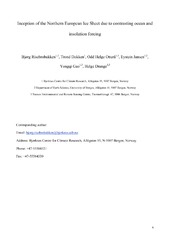| dc.contributor.author | Risebrobakken, Bjørg | eng |
| dc.contributor.author | Dokken, Trond Martin | eng |
| dc.contributor.author | Otterå, Odd Helge | eng |
| dc.contributor.author | Jansen, Eystein | eng |
| dc.contributor.author | Gao, Yongqi | eng |
| dc.contributor.author | Drange, Helge | eng |
| dc.date.accessioned | 2007-02-07T13:01:39Z | |
| dc.date.available | 2007-02-07T13:01:39Z | |
| dc.date.issued | 2007-01 | eng |
| dc.Published | Quaternary Research 67(1): 128-135 | |
| dc.identifier.issn | 0033-5894 | en_US |
| dc.identifier.uri | https://hdl.handle.net/1956/2088 | |
| dc.description.abstract | About 115,000 years ago the last interglacial reached its terminus and nucleation of new ice sheet growth was initiated. Evidence from the northernmost Nordic Seas indicate that the inception of the last glacial was related to an intensification of the Atlantic Meridional Overturning Circulation (AMOC) in its northern limb. The enhanced AMOC, combined with minimum Northern hemisphere insolation, introduced a strong sea-land thermal gradient that together with a strong wintertime latitudinal insolation gradient increased the storminess and moisture transport to the high northern European latitudes, at a time when the Northern hemisphere summer insolation approached its minimum. | en_US |
| dc.format.extent | 1155564 bytes | eng |
| dc.format.mimetype | application/pdf | eng |
| dc.language.iso | eng | eng |
| dc.publisher | Elsevier | en_US |
| dc.subject | Glacial inception | eng |
| dc.subject | Nordic seas | eng |
| dc.subject | Northern European ice sheets | eng |
| dc.subject | Paleo-reconstruction: OGCM | eng |
| dc.subject | AMOC | eng |
| dc.title | Inception of the Northern European Ice Sheet due to contrasting ocean and insolation forcing | en_US |
| dc.type | Peer reviewed | |
| dc.type | Journal article | |
| dc.description.version | Accepted version | en_US |
| dc.rights.holder | Copyright 2006 University of Washington. All rights reserved | en_US |
| dc.identifier.doi | https://doi.org/10.1016/j.yqres.2006.07.007 | |
| dc.source.journal | Quaternary Research | |
| dc.source.40 | 67 | |
| dc.source.14 | 1 | |
| dc.source.pagenumber | 128-135 | |
| dc.subject.nsi | VDP::Matematikk og Naturvitenskap: 400 | nob |
